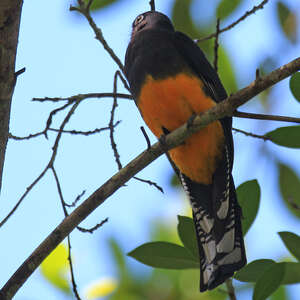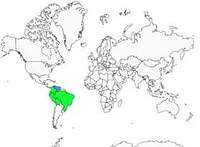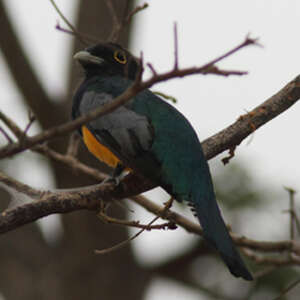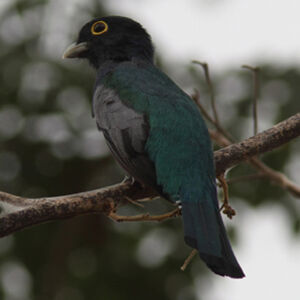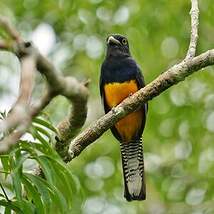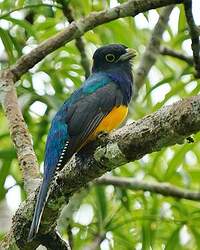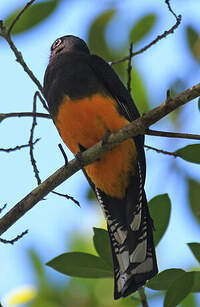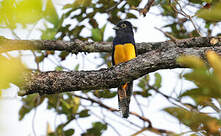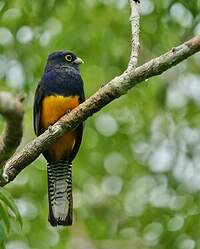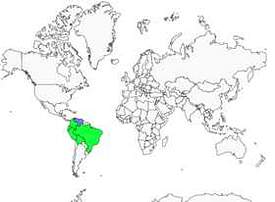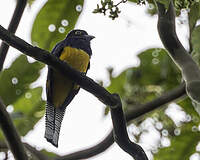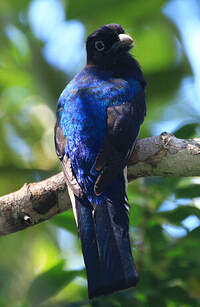Amazonian Trogon
Trogon ramonianus - Trogon d'Amazonie
Identification
The Amazonian Trogon, scientifically known as Trogon ramonianus, was discovered by two French ornithologists: Emile Deville (1824-1853) and Marc Athanase Parfait Oeillet Des Murs (1804-1878) in 1849. In Latin, ramus means branch and in Old French, ramon means broom. Did they want to make reference to the fact that our Amazonian Trogon is almost always seen perched on a branch, flicking its tail and sweeping the air? Trogon ramonianus was originally a subspecies of the Violet Trogon, although it was in 2010 that the SACC (South American Classification Committee) raised it to species status, something that apparently not everyone recognizes. It has all the characteristics of the Violet Trogon - a size of 23 to 25 cm - and its colors are only slightly different; its breast, throat and parotid area are black, its top of the head and nape are violet-blue, its beak is pale blue, and its orbital ring is yellow with a dark brown iris. Its chest is a more blue than violet blue color, compared to the Violet Trogon, with a barely visible white line between its chest and yellow belly. One of the distinguishing marks between the Violet and Amazonian Trogon is the absence of vermiculation on its coverts which are grey; its mantle and back have shades of blue-turquoise rather than green, though lighting can distort color perception. The female does not differ much from the female Violet Trogon, having a grey head with a pale blue beak whose culmen is marked by black, the eye is surrounded by two half white circles in the front and back, the breast, scapulars mantle and back are grey, and the coverts have distinct black and white horizontal vermiculations. Its three pairs of lower rectrices are white, with black marks in the centre in the shape of arrows, the points of which are turned downwards, and the exterior parts are striped with horizontal black lines.
Subspecific information 2 subspecies
- Trogon ramonianus ramonianus (w Amazonia)
- Trogon ramonianus crissalis (ec Amazonian Brazil. between the Madeira and the Tapajós Rivers.)
Foreign names
- Trogon d'Amazonie,
- Trogón Amazónico,
- surucuá-pequeno,
- Amazonastrogon,
- Amazonetrogon,
- amazontrogon,
- Amazontrogon,
- trogón pralesný,
- Amazontrogon,
- amazoniantrogoni,
- trogon amazoński,
- Амазонский трогон,
- アマゾンキヌバネドリ,
- 亚马逊咬鹃,
- amazontrogon,
- 亞馬遜美洲咬鵑,
Voice song and call
Habitat
The tropical primary forest is its domain, with the Amazonian forest foremost. Due to the large distribution area of the Violet Trogon, it is likely that Amazonian Trogon (Trogon ramonianus) prefers the canopy at heights of around twenty metres. It can be found in the Terra firme of the Amazon, close to the mangroves.
Dietfeeding habits
Reproduction nesting
The breeding period is as large as its range, February in Venezuela, March in Colombia, curiously few information exist in Brazil. The nest is excavated in a hollowed tree, an old wasp nest or an old arboreal termitarium. The lack of information, maybe due to its difficulty to observe within the tropical forest, only allows comparisons with the Purple Trogon: two to three eggs incubated for 17 days. Nothing is known about the rearing of the young and their flight.
Geographic range
Given its name, it is of course largely resident in Brazilian Amazonia, but also in all Amazonian parts of Peru, Colombia, Ecuador, north Bolivia, possibly in Brazilian Pantanal, present in Trinidad. It is very difficult to isolate a strict distribution area, Birdlife giving an immense zone where the boundaries between the subspecies of Violaceous Trogon lay next to the residense area of Amazonian Trogon, hybrids on the meeting zones being likely.
Threats - protection
IUCN conservation status
concern
in the Wild
threatened
evaluated
LC does not present any particular concerns, apart from the inflationary deforestation of the Amazon. Finally, one might wonder why a subspecies which presents so few differences with the nominal species Amazonian Trogon be elevated to the level of a species?
Sources of information
- IOC World Bird List (v15.1), Gill, F and D Donsker (Eds). 2025-12-07.
- A Natural history of the Trogonidae, Joseph M.Forshaw Albert Earl Gilbert
- Vol. 6 - Handbook of the Birds of the World, Josep del Hoyo-Andrew Elliott-Jordi Sargatal
- xeno-canto, Sharing bird sounds from around the world,
- Avibase, Lepage Denis
- BirdLife International, BirdLife International
- Neotropical Birds Online,
- Planet of Birds,
- Wikipédia, Wikipedia, The Free Encyclopedia
Other sources of interest
 Specification sheet created on
03/08/2023 by Anne et Gabriel Leboff
Specification sheet created on
03/08/2023 by Anne et Gabriel LeboffTranslation by AI Oiseaux.net
© 1996-2025 Oiseaux.net
- Accipitriformes
- Aegotheliformes
- Anseriformes
- Apodiformes
- Apterygiformes
- Bucerotiformes
- Caprimulgiformes
- Cariamiformes
- Casuariiformes
- Charadriiformes
- Ciconiiformes
- Coliiformes
- Columbiformes
- Coraciiformes
- Cuculiformes
- Eurypygiformes
- Falconiformes
- Galliformes
- Gaviiformes
- Gruiformes
- Leptosomiformes
- Mesitornithiformes
- Musophagiformes
- Nyctibiiformes
- Opisthocomiformes
- Otidiformes
- Passeriformes
- Pelecaniformes
- Phaethontiformes
- Phoenicopteriformes
- Piciformes
- Podargiformes
- Podicipediformes
- Procellariiformes
- Psittaciformes
- Pterocliformes
- Rheiformes
- Sphenisciformes
- Steatornithiformes
- Strigiformes
- Struthioniformes
- Suliformes
- Tinamiformes
- Trogoniformes

